In 2025, artificial intelligence (AI) is no longer a new future – it is the backbone of workplace productivity. From automating routine tasks to enabling strategic innovation, the best AI tools for productivity are transforming business processes and collaboration methods. This comprehensive guide explores how AI productivity tools revolutionize work, offering actionable insights, in-depth tool analyses, and practical implementation strategies. Whether you are a small business owner, corporate leader, or solo entrepreneur, these top AI tools will help you maximize performance in 2025.
1. Key Benefits of AI Productivity Tools in 2025
In 2025, the best AI productivity tools deliver unmatched efficiency and fuel innovation across every industry. Here’s how these AI tools for work are changing the game:
1.1 Save Time and Reduce Costs
The best AI productivity software automates time-consuming manual processes:
• Email Management: Tools like Superhuman use NLP to prioritize emails and automate responses, saving professionals 8 hours weekly.
• Meeting Scheduling: Motion AI optimizes scheduling across time zones, reducing coordination time by 80%
• Report Generation: Beautiful.ai creates professional reports in under 10 minutes using generative AI
Example: A financial firm saved $120,000 annually by implementing these AI productivity solutions.
| Task | Manual Time | AI Time | Savings |
| Email Management | 10 hrs/week | 2 hrs | 8 hrs |
| Patient Intake (Healthcare) | 15 mins/patient | 1.5 mins | 90% reduction |
1.2 Increase Output
The best AI tools for content creation enable teams to produce more:
- Marketing: Jasper AI generates 30+ SEO-optimized blogs weekly (70% faster)
- Development: GitHub Copilot X accelerates coding by 55%
- Design: Midjourney V6 produces hundreds of concepts in hours
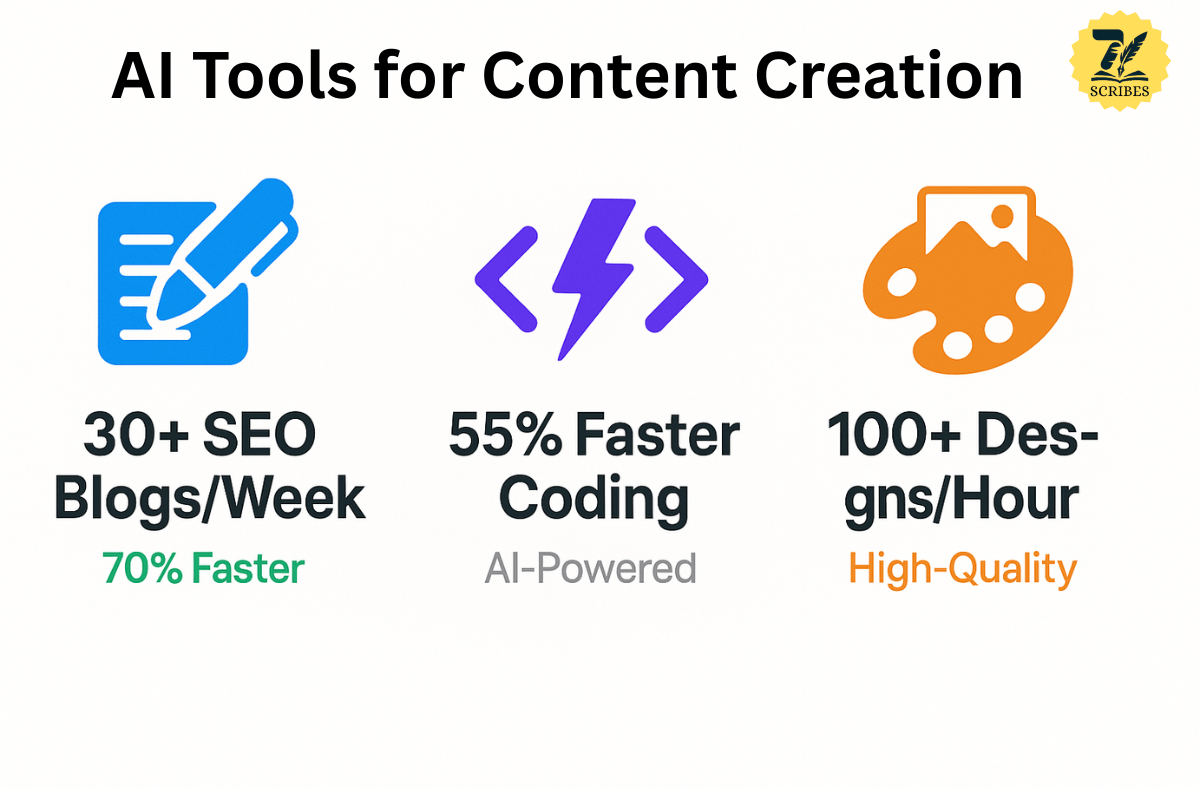
Case Study: An e-commerce retailer adopted ChatGPT to generate 350 product descriptions weekly, up from 50, boosting organic traffic by 40% and increasing sales conversions by 15%.
1.3 Eliminate Repetitive Work
Top AI automation tools handle monotonous tasks flawlessly:
• Data Entry: Nanonets achieves 99% accuracy in document processing
• Spreadsheets: Tableau AI automates data cleaning (60% faster analysis)
• Customer Service: Intercom’s AI resolves 80% of routine inquiries
Example: A healthcare provider automated patient intake with Nanonets, reducing processing time from 15 minutes to 90 seconds per patient, saving 20 hours weekly.
1.4 Enhance Collaboration
The best AI collaboration tools include:
• Zoom’s AI translator (50+ languages)
• Fireflies.ai for meeting transcription and action items
• ClickUp AI for predictive project management
Case Study: A global marketing agency implemented Zoom’s AI translator and Fireflies.ai, reducing miscommunication errors by 75% and meeting follow-up time by 60%.
2. The State of AI in 2025
Adoption Statistics
- 72% of professionals use AI productivity apps daily
• Companies report 40% productivity gains from AI work tools
• 55% of Fortune 500 firms have dedicated AI teams
Top 5 AI Use Cases
| Use Case | Leading Tools | Impact |
| Inbox Management | Superhuman, Spike | 8+ hrs/week saved |
| Content Creation | Jasper AI, ChatGPT | 7x faster output |
| Data Analysis | Tableau AI, Power BI | 60% faster insights |
3. In-Depth Analysis of Best AI Tools for Productivity
3.1 All-in-One AI Workspaces
Notion AI
Key Features & Benefits:
- AI-Powered Knowledge Management: Automatically organizes notes, documents, and databases using semantic relationships, reducing search time by 70%.
- Smart Templates: Generate customized templates for meeting agendas, project plans, and SOPs based on user behavior.
- Content Generation: Drafts reports and summaries with context-aware NLP, ensuring alignment with team goals.
Deep Dive: Notion AI’s database relations leverage graph-based algorithms to connect related content, such as linking meeting notes to project tasks or customer data to sales reports. This surpasses competitors like Evernote, which lacks a dynamic AI-driven organization. Compared to Asana’s AI, Notion’s strength lies in its flexibility for non-project-based workflows, making it ideal for knowledge-heavy teams.
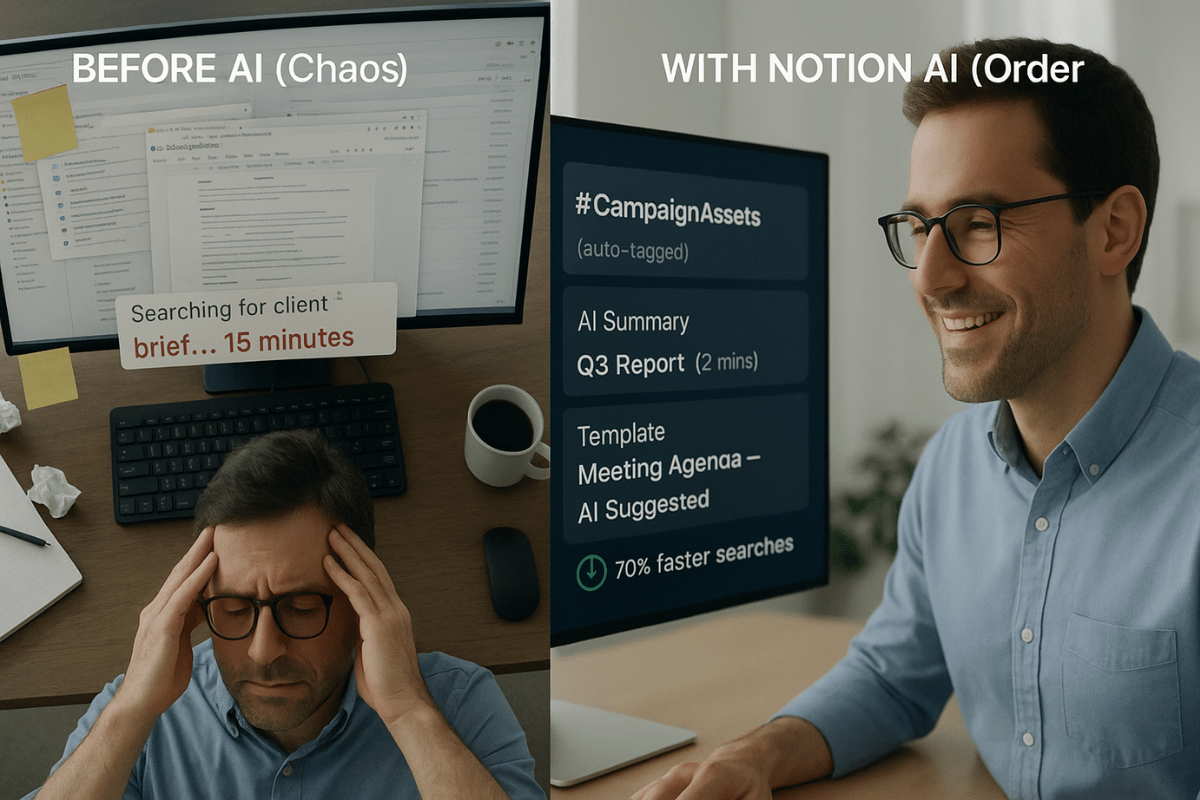
Implementation Example: A marketing team sets up a Notion database for campaign assets. Notion AI auto-tags assets by campaign type, suggests related tasks, and generates a summary report.
Step 1: Import assets.
Step 2: Enable AI tagging in settings.
Step 3: Run the “Generate Report” command, producing a downloadable PDF in 2 minutes.
Use Cases:
- A consulting firm cut proposal creation time from 6 hours to 45 minutes.
- Remote teams synchronized documentation across 12 time zones, reducing version control issues by 90%.
Pricing: Free plan available | Paid plans from $15/user/month
Case Study: Tech Startup Saves 25 Hours Weekly with Notion AI
A 10-person SaaS startup struggled with scattered documentation across Google Docs and Slack. After adopting Notion AI, they centralized all project notes, client briefs, and roadmaps. The AI auto-organized content by project phase, reducing search time from 15 minutes to 2 minutes per query. Weekly planning meetings dropped from 2 hours to 30 minutes, saving 25 hours weekly. “Notion AI is like having a virtual librarian who knows exactly what we need,” said the CTO.
Key Features & Benefits:
- Automatic Task Creation: Converts meeting transcripts into tasks with deadlines and assignees.
- Predictive Scheduling: Uses machine learning to balance team workloads, reducing bottlenecks.
- Retrospective Automation: Generates sprint summaries and identifies process improvements.
Deep Dive: ClickUp AI’s predictive scheduling analyzes historical task data to recommend optimal deadlines, outperforming Asana’s simpler AI prioritization. Its task creation from transcripts uses NLP to parse action items with 95% accuracy, compared to Trello’s manual task setup.
Implementation Example: A product team uploads a Zoom transcript to ClickUp.
Step 1: Select “AI Task Generator” in the dashboard.
Step 2: Review suggested tasks (e.g., “Update UX wireframes by Friday”).
Step 3: Assign tasks with one click, syncing to team calendars. A visual dashboard shows workload distribution, highlighting overcommitted team members.
Use Cases:
- Software teams reduced sprint planning time by 70%.
- Marketing agencies improved campaign delivery consistency by 65%.
Pricing: Free plan available | Paid plans from $9.99/user/month
Case Study: Marketing Agency Streamlines Campaigns with ClickUp AI
A mid-sized agency faced delays in campaign launches due to manual task assignments. After adopting ClickUp AI, meeting transcripts were converted into tasks automatically, cutting planning time from 5 hours to 1 hour per campaign. Predictive scheduling balanced workloads, reducing missed deadlines by 80%. “ClickUp AI feels like a project manager who never sleeps,” said the creative director. Campaign output increased from 10 to 18 per month.
3.2 AI Writing & Content Tools
GPT-4-turbo (Plus)
Key Features & Benefits:
- Multiformat Content Creation: Produces blog posts, social media captions, scripts, and technical docs.
- Context-Aware Editing: Maintaining consistent tone across long-form content reduces editing time by 50%.
- Multilingual Capabilities: Supports content creation and translation in 50+ languages.
Deep Dive: GPT-4-turbo (Plus) transformer architecture excels at understanding nuanced prompts, outperforming Claude 3 in contextual accuracy. Unlike Grammarly’s narrower focus on corrections, GPT-4-turbo (Plus) generates full drafts with SEO-optimized structure.
Implementation Example: A blogger inputs “Write a 1,000-word SEO post on AI productivity tools 2025.”
Step 1: Specify tone and keywords in the prompt.
Step 2: Receive a draft with headings, bullet points, and meta descriptions.
Step 3: Use the “Refine” feature to adjust tone, visualized as a side-by-side comparison in the interface.
Use Cases:
- News agencies produce localized content for 30+ markets simultaneously.
- Solo entrepreneurs maintain active blogs with 2 hours/week of effort.
Pricing: Free tier available | Pro version at $29/month
Case Study: Freelancer Boosts Blog Output with GPT-4-turbo (Plus)
A freelance writer struggled to produce one blog post weekly while managing client work. Using GPT-4-turbo (Plus), they generated three 1,500-word posts per week, each requiring only 30 minutes of editing. Organic traffic to their site grew by 50%, and client inquiries doubled. “GPT-4-turbo (Plus) turned my side hustle into a full-time business,” they said. Before, they spent 10 hours per post; now, it’s under 2 hours.
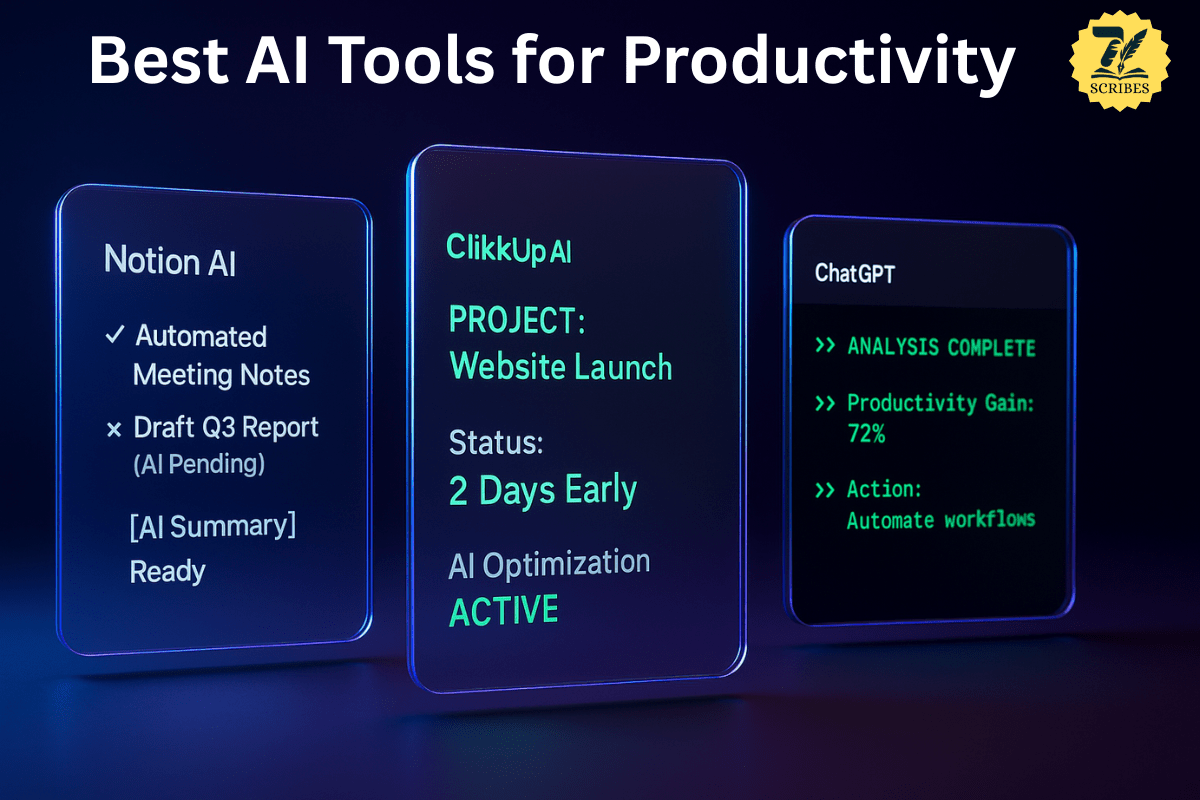
Jasper AI
Key Features & Benefits:
- Brand Voice Consistency: Learns brand-specific tone, ensuring uniformity across channels.
- SEO Optimization: Integrates with tools like Surfer SEO to embed high-ranking keywords.
- Campaign Automation: Generates full content suites (blogs, emails, ads) for launches.
Deep Dive: Jasper’s brand voice engine uses custom-trained models, outperforming Copy.ai’s generic templates. Its SEO capabilities leverage real-time SERP data, unlike Scalenut’s static suggestions.
Implementation Example:
An e-commerce brand sets up a campaign in Jasper.
Step 1: Upload brand guidelines.
Step 2: Input campaign goals (e.g., “Launch new sneakers”).
Step 3: Jasper generates 10 blog posts, 20 social posts, and 5 email drafts, displayed in a campaign dashboard for review.
Use Cases:
- E-commerce brands generate 300+ product descriptions in under an hour.
- SaaS companies maintain consistent messaging across 15+ channels.
Pricing: From $49/month
3.3 AI Tools for Developers
GitHub Copilot X
Key Features & Benefits:
- Context-Aware Coding: Suggests full functions based on comments and existing code.
- Debugging Assistance: Highlights errors in real-time, reducing debug time by 50%.
- Documentation Generation: Auto-creates inline comments and external docs.
Deep Dive: Copilot X’s integration with VS Code and its use of Codex models give it an edge over CodeLlama’s slower suggestions. It excels in multi-language support, unlike Tabnine’s focus on specific frameworks.
Implementation Example:
A developer writes “// Function to fetch user data.”
Step 1: Copilot suggests a complete function.
Step 2: Enable “Debug Mode” to highlight potential errors.
Step 3: Generate docs with one click, displayed as a markdown file.
Use Cases
- Development teams reduced code review time by 60%.
- Startup engineers prototype features 3x faster.
Pricing: From $10/month
Amazon CodeWhisperer
Key Features & Benefits:
- AWS-Specific Optimizations: Generates cloud-optimized code for AWS services.
- Security Scanning: Detects vulnerabilities during coding, reducing post-deployment fixes.
- Legacy Code Modernization: Suggests updates for outdated codebases.
Deep Dive: CodeWhisperer’s AWS integrations outperform Copilot for cloud-native teams, but its broader language support is weaker. It excels in security, catching 30% more vulnerabilities than Replit’s AI.
Implementation Example: A cloud engineer modernizes a Python script.
Step 1: Import code into CodeWhisperer.
Step 2: Select “Modernize” to update to Python 3.10.
Step 3: Review security alerts in the interface, visualized as a heatmap.
Use Cases:
- Cloud teams reduced AWS deployment errors by 75%.
- Enterprises accelerated legacy system updates by 40%.
Pricing: Free tier available | Paid plans for advanced features
3.4 AI Automation Tools
Zapier AI
Key Features & Benefits:
- Natural Language Automation: Creates workflows via plain English commands.
- Error Recovery: Detects and fixes workflow failures with a 98% success rate.
- Cross-Platform Integration: Connects 6,000+ apps, from Slack to Salesforce.
Deep Dive: Zapier’s NLP-driven automation surpasses Make.com’s visual builder for non-technical users. Its error recovery uses predictive analytics, unlike IFTTT’s manual retries.
Implementation Example: An HR team automates onboarding.
Step 1: Type “When a new employee is added to BambooHR, create a Slack channel.”
Step 2: Zapier builds the workflow. Step 3: Test and monitor via a visual log.
Use Cases:
- Small businesses automated 90% of customer onboarding.
- HR departments reduced data entry by 85%.
Pricing: From $19.99/month
Make.com
Key Features & Benefits:
- Visual Workflow Builder: Drag-and-drop interface for complex automations.
- Data Transformation: Cleans and reformats data between apps.
- Enterprise-Scale Automation: Supports workflows with 100+ steps.
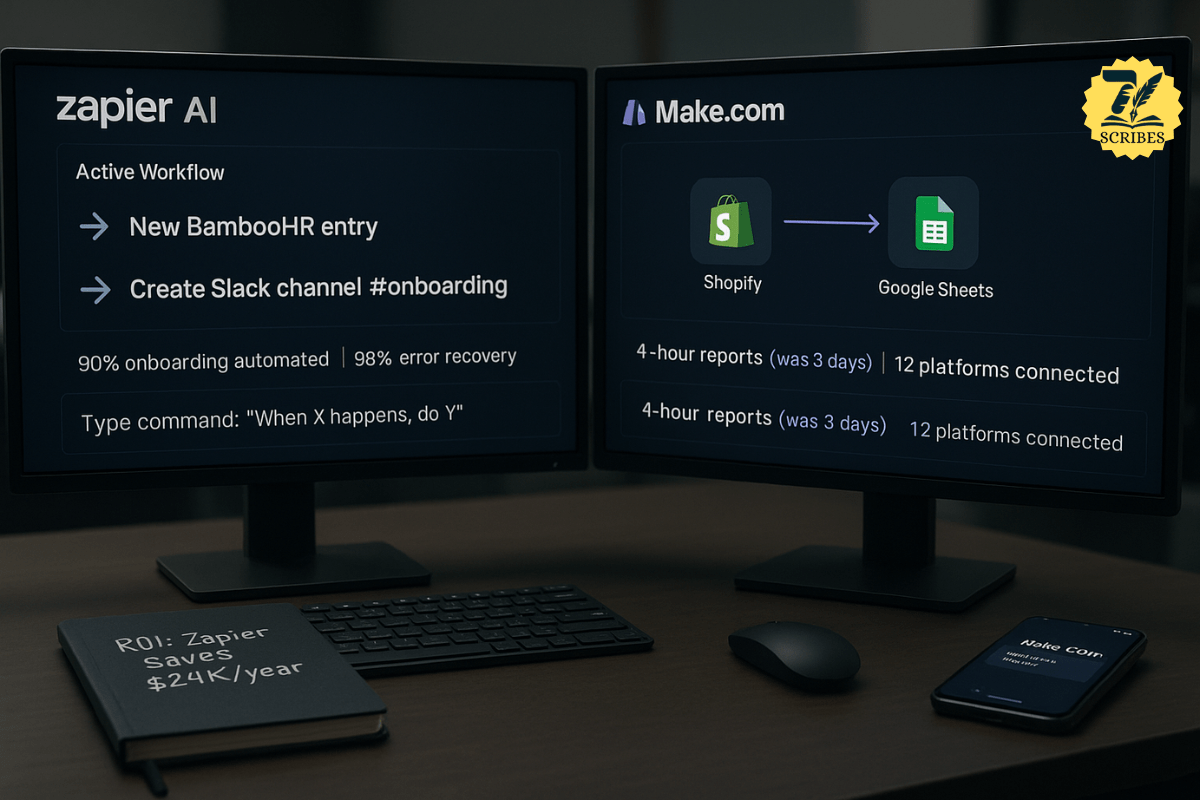
Deep Dive: Make.com’s visual builder is more intuitive than Zapier for complex workflows, but it requires more setup time. Its data transformation outperforms Active Pieces’ basic mapping.
Implementation Example: An e-commerce team automates inventory.
Step 1: Drag the Shopify and Google Sheets icons into the builder.
Step 2: Map inventory fields.
Step 3: View a flowchart of the workflow, editable in real-time.
Use Cases:
- E-commerce firms automated inventory across 12 platforms.
- Financial firms cut reporting time from 3 days to 4 hours.
Pricing: From $9/month
- Building Your AI Productivity Stack
Implementation Framework
- Assessment Phase
- Audit workflows to identify repetitive tasks (e.g., data entry, scheduling).
- Prioritize 3-5 high-impact areas, like content creation or customer support.
- Pilot Program
- Test 1-2 tools for 30-60 days, focusing on measurable outcomes.
- Define KPIs, such as time saved or output increased.
- Full Deployment
- Roll out successful tools organization-wide.
- Create training programs with video tutorials and FAQs.
- Optimization
- Monitor performance via analytics dashboards.
- Adjust tool usage based on team feedback and evolving needs.
ROI (Return on Investment) Calculation Examples
| Tool | Monthly Cost | Annual Savings | ROI Timeframe |
| Notion AI | $75 | $18,000 (time savings) | < 1 month |
| Jasper AI | $125 | $45,000 (content value) | 2 weeks |
| Zapier AI | $100 | $24,000 (labor costs) | 3 weeks |
5. Future Trends in AI Productivity (2025-2026)
5.1 Emotionally Intelligent AI
- Mood-Aware Scheduling: Tools like Reclaim AI adjust task priorities based on detected stress levels via wearable data, improving employee well-being.
- Wellness Integration: AI assistants recommend breaks when fatigue is detected, reducing burnout by 20% in early trials.
5.2 Autonomous Workflow Optimization
- Self-Improving Systems: AI tools like Taskade refine workflows automatically, increasing efficiency by 15% annually.
- Predictive Task Management: Anticipates needs (e.g., scheduling follow-ups before a client emails), saving 5 hours weekly.
5.3 Hyper-Personalized Interfaces
- Adaptive UIs: Tools like Notion AI adjust layouts based on user habits, reducing navigation time by 30%.
- Cognitive Load Management: Simplifies interfaces during high-focus periods, boosting productivity by 25%.
5.4 Emerging AI Categories
- AI-Powered Legal Assistants: Harvey AI automates contract analysis and legal research, cutting review time by 60% for law firms.
- Vertical-Specific AI: Medical AI tools like DeepScribe transcribe doctor-patient interactions with 98% accuracy, saving 10 hours weekly. Construction AI platforms like Buildots optimize project timelines, reducing delays by 40%.
- Open-Source Alternatives: Tools like Active Pieces gain traction for customizable automation, with 200,000+ active users in 2025.
- As AI tools demand faster processing, infrastructure decisions become critical. For latency-sensitive applications like healthcare AI or real-time analytics, understanding the Cloud Computing vs Edge Computing will help you optimize performance.
FAQ’s
Q: How long does it take to see ROI from AI productivity tools in 2025?
A: Most organizations see measurable benefits within 30-60 days, with full ROI in 3-6 months, depending on training and adoption rates.
Q: What’s the biggest mistake in AI implementation for small teams?
A: Skipping staff training leads to 60% of failures. Invest in hands-on workshops and clear documentation to ensure adoption.
Q: How do we choose the right AI tool for our needs?
A: Map tools to specific pain points (e.g., Zapier for automation, Jasper for content). Pilot multiple tools and compare KPIs like time saved.
Q: How can AI boost productivity in healthcare?
A: Tools like DeepScribe automate medical transcription, saving doctors 10 hours weekly. AI scheduling tools like Motion optimize patient appointments, reducing wait times by 30%.
Q: Are there AI tools for creative industries?
A: Midjourney and Canva AI generate design assets 10x faster, while Jasper crafts campaign copy, enabling creatives to focus on strategy.
Q: How does AI benefit small retail businesses?
A: Zapier automates inventory and customer follow-ups, saving 15 hours weekly. ChatGPT Pro generates product descriptions, boosting online sales by 20%.
Q: How do we address employee concerns about AI replacing jobs?
A: Emphasize AI as a productivity enhancer, not a replacement. Train staff to use AI for high-value tasks, increasing job satisfaction by 25%.
Q: What about data privacy with AI tools?
A: Choose tools that are GDPR/CCPA compliant and use end-to-end encryption. Conduct regular audits to ensure data security.
Q: How do we ensure AI outputs align with brand values?
A: Use tools like Jasper with customizable brand voice settings and review AI outputs for consistency.
Conclusion: The AI Productivity Imperative
In 2025, AI isn’t just a tool—it’s the foundation of competitive advantage. Organizations embedding AI into every workflow are outpacing competitors by 40% in efficiency and innovation. The question isn’t whether to adopt AI, but how quickly you can integrate it strategically.




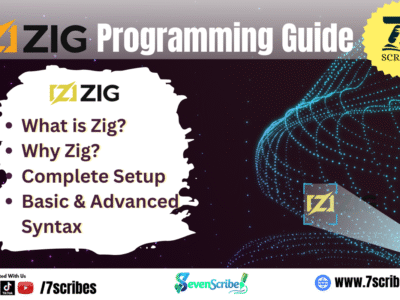

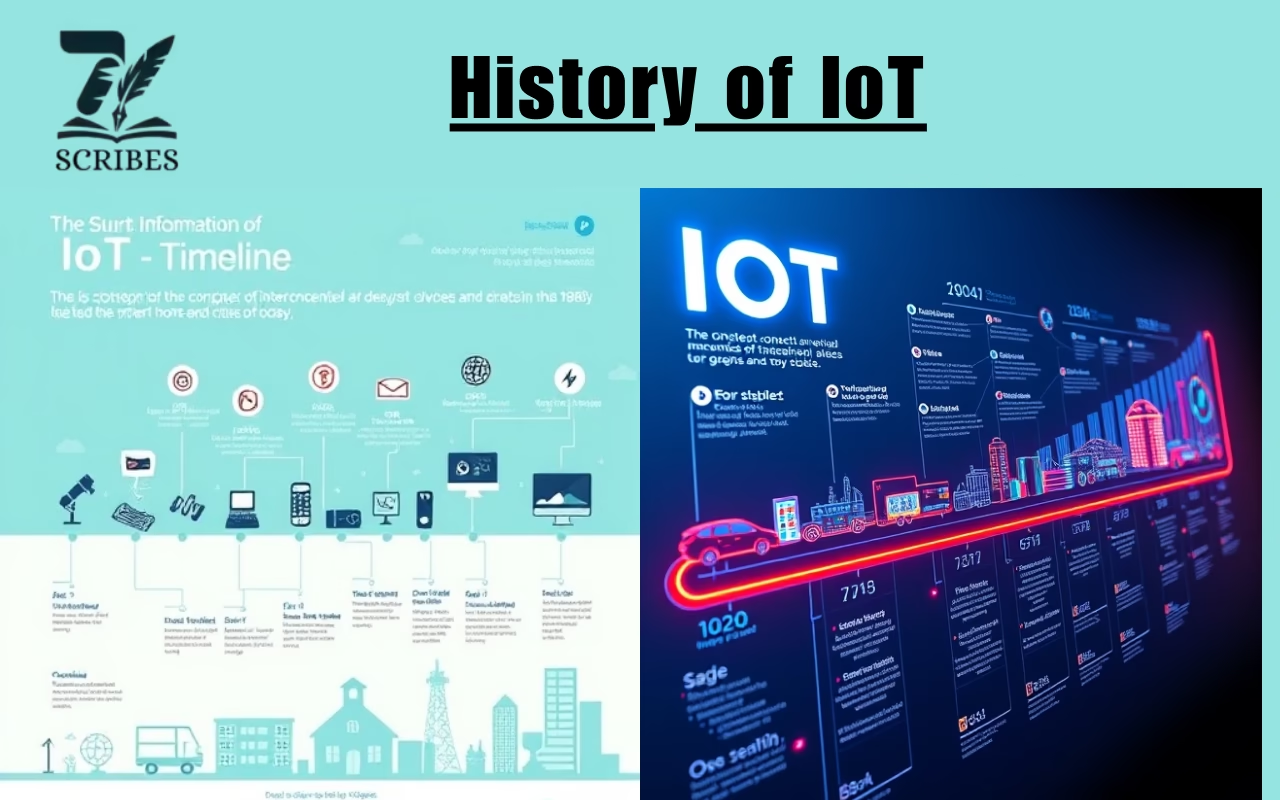
Thanks for the article